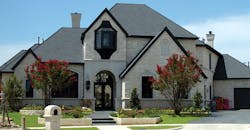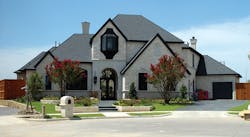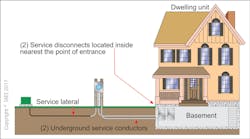Let’s begin with a review of some common installation methods that are used to provide power to larger single-family dwellings. All references are based on the 2017 edition of the NEC with a few comments related to changes being proposed for the 2020 NEC.
As with any building that power is supplied to, our reference should be Art. 220. This is where the requirements for load calculations for the specified installation can be found. However, for the discussion that follows, we will assume that the calculations have already been performed, and it is necessary to install a 400A service, or feeder, to the dwelling.
In these larger, more expensive dwellings, it’s common that they are not fed with overhead service drops or overhead service conductors. Instead, they are typically fed through an underground feed. It is common to have a 400A (actually 320A) meter socket mounted on a pedestal at the outer edge of the property. Then, two sets of conductors are routed underground through the basement wall directly into the back of two 200A main breaker panelboards.
The first requirement in Art. 230 you must follow is the permissive language found in Sec. 230.2, which states, “For the purpose of 230.40, Exception No. 2 only, underground sets of conductors, 1/0 AWG and larger, running to the same location and connected together at their supply end but not connected together at their load end shall be considered to be supplying one service.”
When looking at Exception No. 2 in Sec. 230.40, it references two to six disconnecting means in separate enclosures and grouped in one location. As you can see so far, we are fine with the installation described above. It meets Code.
Let’s look a little deeper into Art. 230 at some other requirements. Section 230.70(A)(1) mandates that the disconnect(s) be installed in a readily accessible location either inside or outside the building or structure; inside must be nearest the point of entrance. In our design noted above, the panelboards located on the interior basement wall are acceptable. Section 230.71(A) permits up to six switches or circuit breakers to serve as the service disconnecting means. Section 230.72(A) requires the disconnecting means to be grouped in one location (Fig 1).
Let’s look at a similar but different installation. In this example, we still have two 200A panelboards attached to the interior basement wall, which are fed from two different sets of conductors. However, instead of only having a meter socket at the outer edge of the property, we install a meter with two 200A circuit breakers. These circuit breakers now become the service disconnect, and the conductors from this equipment to the two panelboards that we installed in the basement are now considered feeder conductors. In evaluating this installation, we need to refer to Art. 225 for outside branch circuits and feeders. In evaluating this arrangement, the main concern is Sec. 225.30, which reads as follows: “A building or other structure that is served by a branch circuit or feeder on the load side of a service disconnecting means shall be supplied by only one feeder or branch circuit unless permitted in 225.30(A) through (E).”
Here’s the dilemma! We can supply two panelboards as service equipment directly through the basement wall, but when we place overcurrent protection ahead of the conductors, it is no longer permitted (Fig. 2).
As part of the 2020 Code change cycle, Code-Making Panel No. 10 accepted a proposed change that reads:
“225.30(B) Common Supply Equipment. Where feeder conductors originate in the same panelboard, switchboard, or other distribution equipment, and each feeder terminates in a single disconnecting means, not more than six feeders shall be permitted. Where more than one feeder is installed in accordance with this section, all feeder disconnects in the building or structure supplied shall be grouped in the same location, and the requirements of 225.33 shall not apply. Each disconnect shall be marked to indicate the load served.”
This is the committee statement attached to the change:
“This revision will prescriptively permit more than one feeder under very limited circumstances. This new text will permit up to six feeders to supply a building or structure under the following conditions:
“(1) Each feeder must originate in the same panelboard, switchboard or other distribution equipment. This provision is safety driven in that all of the feeders supplying a building or structure are not only required to be in the same location, they must be located in the same distribution equipment.
“(2) Each feeder must terminate in a single disconnecting means. This revision prohibits the application of Sec. 225.33 which permits up to six disconnecting means from a single feeder.
“(3) Where more than one feeder is installed in accordance with this section all feeder disconnects in the building or structure supplied are required to be grouped in the same location.
“(4) Each disconnect must be marked to indicate the load served. This revision simply permits multiple feeders, each with a single disconnecting means supplied, instead of a single large feeder with six disconnects. There is no need to limit the size of the feeder conductors as they will be protected at their rated ampacity.
“Additionally, this revision will permit multiple smaller feeders, with smaller conductors and lower rated OCPD’s to allow the designer to reduce the level of arc energy.”
Some will like this Code change; others will not. Which side of the table do you sit on?
Please share your thoughts on this topic by commenting on the online version of this article on the EC&M website.
Rogers is the owner/operator of Bay State Inspectional Agency, Vineyard Haven, Mass. He is an active instructor for IAEI, the wiring inspector for the town of Oak Bluffs, and the chair of NEC Code-Making Panel 4. He can be reached at [email protected].
About the Author
Jim Rogers
Owner
Jim Rogers has more than 50 years of experience in the electrical profession is a licensed journeyman and master electrician, a nationally certified electrical inspector, and an associate electrical engineer. He has managed the Massachusetts Electrical Board and serves on both state and national code committees. He is currently the electrical inspector for the town of Oak Bluffs, Mass., and operates a private inspection and investigation company, Bay State Inspectional Agency.
Rogers represents the International Association of Electrical Inspectors (IAEI) as the chair of NEC Code Making Panel (CMP) 4 for the National Fire Protection Association (NFPA), which has purview over photovoltaic systems and other alternative energy systems. Prior to being assigned to CMP 4, in 2000 he was the alternate to Andy Cartel on CMP 12. He also serves on the NFPA 303 Committee on Boatyards and Marinas. Rogers currently instructs for IAEI. He has previously taught for the International Brotherhood of Electrical Workers (IBEW) and served as an adjunct professor at the Benjamin Franklin Institute of Technology in Boston.
In addition, he has over 40 years of experience in the fire service and retired for the fire service with the rank of assistant chief, as well as serving as the department investigator and team leader for the County Fire Investigation Team. Rogers is a nationally certified fire investigator and certified fire and explosion investigator, as well as a state-certified fire inspector. He also has a bachelor’s degree in fire science from the University of Maryland.



